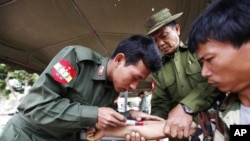Humanitarian organizations giving relief for last week’s deadly earthquake in Burma have praised authorities for their quick response and the sharing of information.
At least 74 people in Burma, and one woman in Thailand, were killed and over 100 injured. But aid organizations say there was a noticeable change in government attitude from past disasters when foreign help was hindered by red tape and suspicion.
Aid organizations in Burma are complimenting the way authorities reacted to a deadly earthquake that hit the country last week.
The 6.8 magnitude quake late Thursday rocked a remote area near Burma's eastern border with Laos and Thailand and was felt as far away as Bangkok and Hanoi.
Hundreds of houses in Shan State, home to the Shan minority, were destroyed or damaged along with schools and monasteries.
Humanitarian organizations scrambled to get emergency supplies to the disaster area. But, unlike past disasters, they say they were impressed by the government’s response.
Chris Herink, Burma country director for World Vision, a Christian aid organization that has staff members living near the earthquake hit area, says Burma’s Relief and Resettlement Department contacted them about providing emergency supplies.
"Very soon after the quake they actually made a request to World Vision to provide food and water," he says. "Subsequently the Ministry of Health has asked us to provide the water purification tablets. It's actually at their request that we've done this. So, that's very positive first and foremost in that they are relying not only on their own capacity but the expertise and resources of other partners to help in this response."
Herink says World Vision was able to quickly provide food and water for over 1,000 villagers left homeless by the earthquake as well as materials for hundreds of temporary shelters.
Burma authorities allowed World Vision and other aid groups as well as the United Nations to quickly access the areas most affected in Tachileik, Tarlay and Mong Lin.
Humanitarian organizations say they are also sharing information on causalities and damage to infrastructure faster than past disasters.
Elisabeth Byrs, a spokeswoman for the U.N.'s Office for the Coordination of Humanitarian Affairs in Geneva, says authorities in Burma, also known as Myanmar, reacted swiftly and efficiently to the emergency.
"Since the last major disaster in Myanmar I think step by step the authorities have understood what the UN and the NGO can do for them and the kind of neutral and impartial assistance they can deliver to the population," says Byrs.
The cooperation stands in stark contrast to May 2008 when Burma was hit by Cyclone Nargis, the worst natural disaster in the country's history.
Nargis swept across the Irrawaddy Delta killing 140,000 people and leaving tens of thousands homeless. But Burma’s military rulers for weeks obstructed emergency aid and foreign workers from reaching those in need.
Herink says they learned a lot from Cyclone Nargis and hopefully trust more in humanitarian groups.
Relief workers say the focus now in the earthquake disaster area is to provide clean drinking water. The quake damaged water storage tanks and pipes and water supplies were contaminated.
Burma is also entering its rainy season raising the risk of landslides which could further complicate relief efforts.









